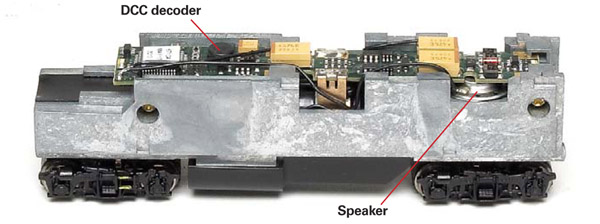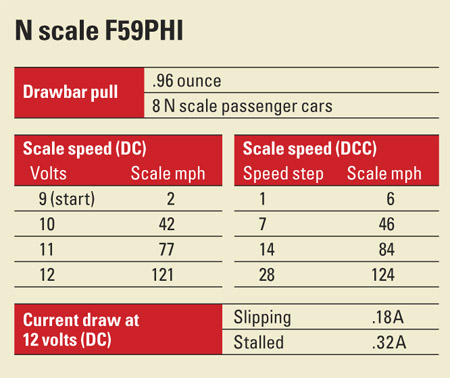Amtrak was the first user of the Electro-Motive Division F59PHI, assigning nine of them to its Capitol Corridor, San Joaquin, and San Diegan passenger trains in California. Since then, Amtrak has put F59PHIs in front of more trains, including the Coast Starlight and Pacific Surfliner. Some regional and commuter lines have also put the locomotives in service, including Metrolink, Sounder, West Coast Express, and San Diego’s Coaster, all of which were offered by Athearn in its first release of this model.
The Northstar Commuter paint scheme on our sample model was smooth and opaque, with crisp edges and color separation. There were a couple voids in the white paint where it crossed a deep molded line on the body shell, but they were small. The lettering was crisp, though one of the nose number boards was slightly off-angle.
Although our sample bears a faithful likeness of the Northstar paint scheme, it’s actually misplaced on this model. The prototype of Northstar no. 502 is an MP36PH-3C, a Motive Power Industries locomotive with a similar streamlined profile. Athearn doesn’t offer an N scale MP36PH-3C, so this model is decorated to fill that niche. In fact, of the F59PHI paint schemes and road numbers Athearn currently offers, only the Amtrak and Trinity Rail Express models are actually F59PHIs.
The rear platform handrails are molded from flexible white plastic. The long grab irons on the body shell are white-painted wire. The grab irons on the back of the locomotive are molded.
Our original review of Athearn’s 2003 locomotive faulted the trucks’ press-on sideframes as having shallow detail. The new models don’t have that problem, with one-piece sideframe assemblies that have plenty of depth. The wheelsets are chemically blackened and in gauge. The McHenry magnetic knuckle couplers are body-mounted at the correct height.
Gently spreading the fuel tank skirts with my fingers allowed the mechanism to come free. Under the hood, the split die-cast-metal frame completely encloses the motor and dual brass flywheels. The DCC decoder sits on top, and the unenclosed 1⁄2″ speaker rests above the rear truck’s gear tower. White surface-mount light-emitting diodes illuminate the forward and back-up lights, an improvement over the yellow LEDs in the early version of this model.
Under DC, the sound decoder started up with authentic engine idle sounds at 7.5 volts (V). As I increased the voltage to 9V, the locomotive started moving, albeit hesitantly. With a touch more voltage, the engine smoothed out. At 12V, the model reached 121 scale mph, close to the prototype’s rated top speed.
Operations under DCC were much smoother. The locomotive rolled at 6.3 scale mph at speed step 1. When I switched the decoder from 28 speed steps to 128, the speed at step 1 dropped to a much more realistic 2 scale mph.
The decoder’s sound effects were authentic, and the tiny speaker put out plenty of volume; while I was testing the locomotive in our workshop, it could be heard out in the hall, 30 feet away. The sound was slightly tinny, but for a 1⁄2″ unenclosed speaker, I thought it was
actually pretty good.
Manufacturer
Athearn Trains
1600 Forbes Way, Suite 120
Long Beach, CA 90810
www.athearn.com
Paint schemes: (three road numbers each unless specified) Northstar Commuter, Amtrak Surfliner (Operation Lifesaver scheme, one road number), Amtrak West, CalTrain, GO Transit, New Mexico Department of Transportation (RailRunner), Trinity Rail Express (two numbers), Utah Front Runner. Fictional paint schemes, two numbers each: Atchison, Topeka & Santa Fe; Pennsylvania RR; Southern Pacific; Southern Ry.
Era: September 1994 to present
Features
- All-wheel electrical pickup
- Five-pole skew-wound motor with flywheels
- McHenry magnetic knuckle couplers, at correct height
- Minimum radius: 9″
- SoundTraxx DCC sound decoder (DCC version only)
- Superbright white light-emitting-diode lights
- Weight: 4 ounces
















